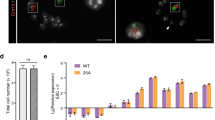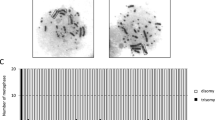Abstract
Targeted modification of human chromosomal alleles by homologous recombination is a powerful approach to study gene function, but gene targeting in mammalian cells is an inefficient process. In contrast, gene targeting in a chicken pre-B cell line, DT40, is highly efficient. We have transferred human chromosome 11 into DT40 cells by microcell fusion, and find that the resulting hybrids are recombination-proficient. In these cells, targeting efficiencies into the chicken ovalbumin locus were >90% and into the human p-globin and Ha-ras loci were 10–15%. These modified human chromosomes can be transferred subsequently to mammalian cells for functional tests. This chromosome shuttle system allows for the efficient homologous modification of human chromosomal genes, and for subsequent phenotypic analyses of the modified alleles in different mammalian cell types
This is a preview of subscription content, access via your institution
Access options
Subscribe to this journal
Receive 12 print issues and online access
$209.00 per year
only $17.42 per issue
Buy this article
- Purchase on Springer Link
- Instant access to full article PDF
Prices may be subject to local taxes which are calculated during checkout
Similar content being viewed by others
References
Capecchi, M.R. Altering the genome by homologous recombination. Science 244, 1288–1292 (1989).
Buerstedde, J.M. & Takeda, S. Increased ratio of targeted to random integration after transfection of chicken B cell lines. Cell 67, 179–188 (1991).
Takata, M. et al. Tyrosine kinases Lyn and Syk regulate B cell receptor-coupled Ca2+ mobilization through distinct pathways. EMBO J. 13, 1341–1349(1994).
Takeda, S., Masteller, E.L., Thompson, C.B. & Buerstedde, J. RAG-2 expression is not essential for chicken immunoglobin gene conversion. Proc. Natl. Acad. Sci. USA 89, 4023–4027 (1992).
Forrester, W.C. et al. A deletion of the human β-globin locus control region causes a major alteration in chromatin structure and replication across the entire β--globin locus. Genes. Dev. 4, 1637–1649 (1990).
Epner, E.M., Kim, C.G. & Groudine, M. What does the locus control region control? Curr. Bid. 2, 262–264 (1992).
Kim, C.G., Epner, E.M., Forrester, W.C. & Groudine, M. Inactivation of the human β-globin gene by targeted insertion into the β--globin locus control region. Genes. Dev. 6, 928–938 (1992).
Li, Y. & Ponce de Leon, F.A. Partitioning of the chicken genome by microcell hybridization. Poultry Sci. 71, 151–160 (1992).
Kao, F.T. Identification of chick chromosomes in cell hybrids formed between chick erythrocytes and adenine-requiring mutants of Chinese hamster cells. Proc. Natl. Acad. Sci. USA 70, 2893–2898 (1973).
Ringertz, N.R. & Bolund, L. Reactivation of chick erythrocyte nuclei by somatic cell hybridization. Intl. Rev. Exp. Path. 13, 83–116 (1974).
Aladjem, M.I. et al. Participation of the human β-globin locus control region in initiation of DMA replication. Science 270, 815–819 (1995).
Fiering, S., Kim, C.G., Epner, E.M. & Groudine, M. An “in-out” strategy using gene targeting and FLP recombinase for the functional dissection of complex DMA regulatory elements: analysis of the β-globin locus control region. Proc. Natl. Acad. Sci. USA 90,, 8469–8473 (1993).
Shapero, M.H., Langston, A.A. & Fournier, R.E.K. Tissue-specific extinguisher loci in the human genome: a screening study based on random marking and transfer of human chromosomes. Somat. Cell Mol. Genet. 20, 215–231 (1994).
Theune, S., Fung, J., Todd, S., Sakaguchi, A.Y. & Naylor, S.L. PCR primers for human chromosomes: reagents for the rapid analysis of somatic cell hybrids. Genomics 9, 511–516 (1991).
Deisseroth, A. & Hendrick, D. Human β-globin expression following chromosomal dependent gene transfer into mouse erythroleukemia cells. Cell 15, 55–63 (1978).
Raich, N.V. et al. Regulated expression of the overlapping ubiquitous and erythroid transcription units of the human porphobilinogen deaminase (PBG-D) gene introduced into non-erythroid and erythroid cells. J. Biol. Chem. 264, 10186–10192 (1989).
Baron, M. & Maniatis, T. Rapid reprogramming of globin gene expression in transient heterokaryons. Cell 46, 591–602 (1986).
Papayannopoulou, T., Enver, T., Takegawa, S., Anagnou, N.P. & Stamatoyannopoulos, G. Activation of developmentally mutated human globin genes by cell fusion. Science 242, 1056–1058 (1988).
Sauer, B. & Henderson, N. Site-specific DNA recombination in mammalian cells by Cre recombinase of bacteriophage P1. Proc. Natl. Acad. Sci. USA 85, 5166–5170 (1988).
Leach, R.J., Thayer, M.J., Schafer, A.J. & Fournier, R.E.K. Physical mapping of human chromosome 17 using fragment-containing microcell hybrids. Genomics 5, 167–176 (1989).
Fiering, S. et al. Targeted deletion of 5′ HS2 of the murine β-globin locus control region reveals that it is not essential for proper regulation of the β-globin locus. Genes. Dev. (in the press).
Charron, J., Malynn, B.A., Robertson, E.J., Goff, S.P. & Alt, F.W. High-frequency disruption of the N-myc gene in embryonic stem and pre-B cell lines by homologous recombination. Mol. Cell. Biol. 10, 1799–1804 (1990).
Xu, L. et al. Replacement of germ-line epsilon promoter by gene targeting alters control of immunoglobulin heavy chain class switching. Proc. Natl. Acad. Sci. USA 90, 3705–3709 (1993).
Bautista, D. & Shulman, M.J. A hit-and-run system for introducing mutations into the Ig H chain locus of hybridoma cells by homologous recombination. J. Immun. 151, 1950–1958 (1993).
Zhen, L. et al. Gene targeting of X chromosome-linked chronic granulomatous disease locus in a human myeloid leukemia cell line and rescue by expression of recombinant gp91phox. Proc. Natl. Acad. Sci. USA 90, 9832–9836 (1993).
Sheseley, E.G. et al. Correction of human beta βS-globin by gene targeting. Proc. Natl. Acad. Sci. USA 88, 4294–4298 (1991).
Gourdeau, H. & Fournier, R.E.K. Genetic analysis of mammalian cell differentiation. Annu. Rev. Cell. Biol. 6, 69–94 (1990).
Choi, O.R. & Engel, J.D. Developmental regulation of β-globin gene switching. Cell 55, 17–26 (1988).
Baba, T.W., Giroir, B.P. & Humphries, E.H. Cell lines derived from avian lymphomas exhibit two distinct phenotypes. Virology 144, 139–151 (1985).
Chen, T.R. In situ detection of mycoplasma contamination in cell culture by fluorescent Hoechst 33258 stain. Exp. Cell Res. 104, 255–262 (1977).
Langston, A.A. & Fournier, R.E.K. Preparation and properties of microcell hybrids. Meth. Mol. Genet. 1, 115–133 (1993).
Stubblefield, E. & Pershouse, M. Direct formation of microcells from mitotic cells for use in chromosome transfer. Somat. Cell Molec. Genet. 18, 485–491 (1992).
Lai, E.C., Woo, S.L., Bordelon-Riser, M.E., Fraser, T.H. & O'Malley, B.W. Ovalbumin is synthesized in mouse cells transformed with the natural chicken ovalbumin gene. Proc. Natl. Acad. Sci. USA 77,, 244–248 (1980).
te Reile, H., Maandag, E.R., Clarke, A., Hooper, M. & Berns, A. Consecutive inactivation of both alleles of the pim–1 proto-oncogene by homologous recombination in embryonic stem cells. Nature 348, 649–651 (1990).
Yuasa, Y. et al. Acquisition of transforming properties by alternative point mutations within c-bas/has human proto-oncogene. Nature 303, 775–779 (1983).
Sauer, B. & Henderson, N. Targeted insertion of exogenous DNA into the eukaryotic genome by the Cre recombinase. New Biol. 2, 441–449 (1990).
Gu, H., Zou, Y.R. & Rajewsky, K. Independent control of immunoglobulin switch recombination at individual switch regions evidenced through Cre-loxP-mediated gene targeting. Cell 73, 1155–1164 (1993).
Trask, B.J., Massa, H., Kenwrick, S. & Gitschier, J. Mapping of human chromosome Xq28 by two-color fluorescence in situ hybridization of DNA sequences to interphase cell nuclei. Am. J. Hum. Genet 48, 1–15 (1991).
Brandriff, B., Gordon, L. & Trask, B. A new system for high-resolution DNA sequence mapping interphase pronuclei. Genomics 10, 75–82 (1991).
Gebhard, W. & Zachau, H.G. Simple DNA sequences and dispersed repetitive elements in the vicinity of mouse immunoglobulin K light chain genes. J. Mol. Biol. 170, 567–573 (1983).
Miller, S.A., Dykes, D.D. & Polesky, H.F. A simple salting out procedure for extracting DNA from nucleated cells.Nucl. Acids Res. 16, 1215 (1988).
Southern, E.M. Detection of specific sequences among DNA fragments separted by gel electrophoresis. J. Mol. Biol. 98, 503–517 (1975).
Author information
Authors and Affiliations
Rights and permissions
About this article
Cite this article
Dieken, E., Epner, E., Fiering, S. et al. Efficient modification of human chromosomal alleles using recombination-proficient chicken/human microcell hybrids. Nat Genet 12, 174–182 (1996). https://doi.org/10.1038/ng0296-174
Received:
Accepted:
Issue Date:
DOI: https://doi.org/10.1038/ng0296-174
This article is cited by
-
Localization of an hTERT repressor region on human chromosome 3p21.3 using chromosome engineering
Genome Integrity (2010)
-
Increased missegregation and chromosome loss with decreasing chromosome size in vertebrate cells
Chromosoma (2006)
-
Topoisomerase II cleavage activity within the human D11Z1 and DXZ1 alpha-satellite arrays
Chromosome Research (2005)
-
Antibody-targeted cell fusion
Nature Biotechnology (2004)
-
The chicken as a model for large-scale analysis of vertebrate gene function
Nature Reviews Genetics (2003)



